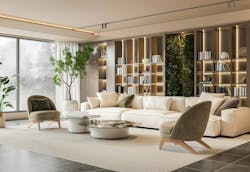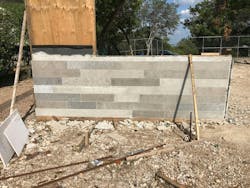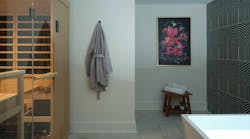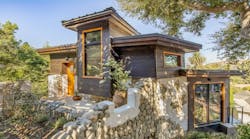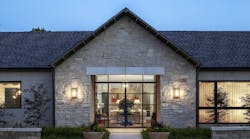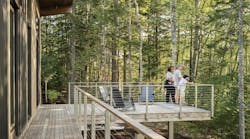Inside the 2025 New Home Trends Summit: Lessons for Custom Builders and Designers
Story at a Glance:
-
Shifting buyers, flexible homes: Delayed life milestones, smaller households, and multi-generational needs are reshaping homebuyer demand.
-
Wellness, placemaking, and transparency are baseline: Biophilic design, thoughtful site planning, and clear communication are no longer optional; they’re expected and signal value and trust.
-
Lessons from production builders: Efficiency, process transparency, and experiential amenities in community building offer insights for custom homes.
I just returned from the New Home Trends Summit in Charleston, S.C., hosted by John Burns Consulting's New Home Trends Institute. Here, community builders, developers, designers, and other industry leaders came together over three days to dissect where the housing market is headed.
Some themes came up repeatedly, offering clear consensus on what’s shifting. But the real value was in a few outlier moments … an idea or comment that made you pause and think. These signals are gold and worth exploring, whether you're building 100 homes or one. Here's what stood out:
1. Delayed Life Stages, Smaller Households
Builders are realigning around the reality that buyers are marrying later, starting families later, and often buying their first home well into their late 30s. Add to that the steady growth of single-person households (projected to hit 35% by 2029) and downsizers looking to simplify.
Why it matters: Don’t assume your next client will be the classic family of four. A “dream home” might mean a flexible plan that supports an aging parent, or a single professional who values guest space, or proximity to urban amenities.
2. Attainability, Luxury: Shared Concerns
While the production world is focused on “attainable” housing, with interest rising in smaller footprints, attached product, cottages and ADUs, and build-to-rent, the underlying theme is about function and efficiency.
Why it matters: For custom builders, that translates to clients asking: How can this house live bigger than its square footage? What value can we offer through ADUs, flexible suites, and layouts that anticipate multiple uses over time? These are conversations around the idea of "value" that will resonate even at the custom level.
3. Wellness Is the New Baseline
Nearly every session touched wellness: biophilic design, circadian lighting, mental health–oriented spaces, outdoor connectivity. As you might already be suspecting, these are no longer perks. They’re expectations.
Why it matters: For custom builders, there's an opportunity to lead with design that goes beyond conventional wellness (cold plunges, spas, etc.) and, instead, leans into well-being: consider daylight studies, acoustics, and meaningful outdoor connections.
Angela Harris of design firm Trio Design explained that there’s growing research indicating that fractal patterns (repetitive geometries found in nature, in everything from fern leaves to river branches) can have a calming effect. She said they've been weaving these patterns into the lighting and detailing of their latest projects to add both beauty and wellness value.
The use of light, including shadows, as a design element was also one of those "aha" moments worth considering (there’s a long tradition in Japanese architecture of doing just that).
4. Community and Placemaking
At the summit, industry leaders defined placemaking as people-centered spaces that prioritize human needs and create community.
Chris Fernandez of architecture firm DAHLIN Architecture | Planning | Interiors said community designers should think about creating that “third place” beyond home and work, incorporating flexible, authentic amenities like a community dance hall (in Texas) or a coffee shop turned cocktail club at night to create immediate community. It's the idea of incorporating retail and commercial amenities "in phase 1, from day 1."
A second strategy? Fernandez emphasized segmentation, ensuring a mix of buyers and typologies so no single housing product dominates, which not only reduces sales risk (you don't have to sell out a single home type), but also enhances social richness with a mix of ages and lifestyles in the community.
Why it matters: In the custom space, placemaking is less about entire neighborhoods and more about ensuring that each home and homeowner feels rooted into their surroundings.
So, it's reflecting local vernacular in home design, blending landscaping into the immediate setting, designing micro amentities that encourage social interaction, and giving more attention to how your custom home fits into the streetscape.
5. Confidence and Trust
Production builders are tackling market uncertainty (rising inflation, recession concerns, and cautious buyers) by making the homebuying process transparent and predictable. As Mark Hirschfeld of real estate developer Thrive Companies put it, “We market confidence.”
In practice, this includes real-time construction updates via apps, efficient building schedules, and “Phase 1, Day 1” amenities like gyms and coffee bars that make communities feel more complete from the start.
Why it matters: Custom clients may not need an app, but they expect radical transparency. Clear updates on schedules, sourcing, and costs (and visible progress on-site) build confidence in your process.
Consider large-scale mockups (below) to faciliate design decisions. Or communicate thoughtful site planning more deliberately, explaining why a home's orientation, lighting, views, and flow were chosen. By doing that, you give clients reassurance that their one-of-a-kind home is being executed with great care.
6. Efficiency as a Differentiator
Production builders obsess over process, organizing construction so that each phase happens in a predictable, repeatable order.
Greg Bennett, CEO of regional builder Smith Douglas Homes, says his schedule is akin to a virtual assembly line: homes are slotted into the schedule and built in that order; it never changes. If one house falls behind, they all fall behind. And while it's tremendous pressure on the trades to perform, he says he's carefully selected his network and assembled a "starting lineup" of the best, making it a culture where the trades are "competitive, but team oriented."
Why it matters: For custom builders, the principle isn’t to replicate an assembly line but to plan and sequence trades thoughtfully, so projects flow smoothly and clients see progress in a predictable way. The more you can streamline behind the scenes, the more bandwidth you have for creativity and service. Efficiency offers reassurance and trust with smoother builds and fewer surprises.
What struck me most at the conference wasn’t the differences between production and custom, but the similarities. What I'm excited to watch is how custom builders, architects, and designers work to meet these same pressures and consumer demands, and interpret them in the way you do best: at a higher level of craft and service.
About the Author
Pauline Hammerbeck
Pauline Hammerbeck is the editor of Custom Builder, the leading business media brand for custom builders and their architectural and design partners. She also serves as a senior editor for Pro Builder, where she directs products coverage and the brand's MVP Product Awards. With experience across the built environment - in architecture, real estate, retail, and design - Pauline brings a broad perspective to her work. Reach her at [email protected].

